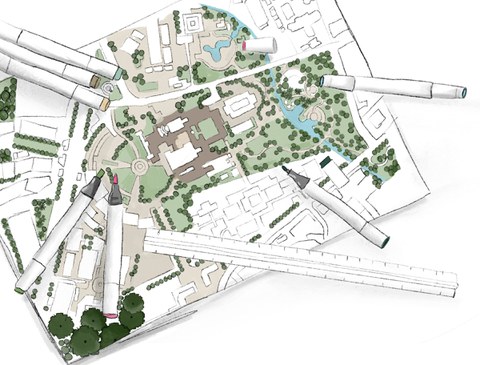Weiterentwicklung der Grünordnungsplanung vor dem Hintergrund aktueller Herausforderungen
Weiterentwicklung der Grünordnungsplanung vor dem Hintergrund aktueller Herausforderungen
Auftraggeber:
Bundesamt für Naturschutz (BfN)
Laufzeit:
09/2022 – 08/2024
Projektteam:
- Technische Universität Dresden (Prof. Dr. C. Schmidt)
- Technische Universität Dresden (Prof. I. Lohaus)
- HHP.raumentwicklung (Dipl.- Ing. G. Hage; M.Sc. L. Riedel)
- Füsser & Kollegen Rechtsanwälte (Dr. M. Lau)
Projektbeschreibung
„Grünordnungspläne 2.0“? Die Ansatzpunkte für eine zeitgemäße Fortentwicklung der Grünordnungspläne sind weichreichend. So beschleunigen sich die Auswirkungen des Klimawandels deutlich und verweisen gerade in bebauten oder zu bebauenden Räumen mit einer Verdopplung der Anzahl an Hitzetagen in nur zwei aufeinanderfolgenden Klimanormalperioden auf einen dringenden Handlungsbedarf zur Klimaanpassung. Die sommerlichen Trocken- und Dürreperioden in den letzten Jahren führten in bebauten Räumen zudem zu erheblichen Trockenschäden und Vitalitätseinbußen der Stadtvegetation. Gleichzeitig nehmen Starkregenereignisse zu, die aufgrund des hohen Versiegelungsgrades in bebauten Räumen und der Zunahme an Siedlungs- und Verkehrsfläche immer häufiger Überschwemmungen auslösen. Grünordnungspläne als Grundlage für Bebauungspläne wie auch als eigenständige Pläne bedürfen vor diesem Hintergrund einer Stärkung klimatischer Festsetzungen. Parallel dazu stecken wir in einer tiefen Biodiversitätskrise, auch in bebauten Räumen. Während politische Programme und Gesetze wie bspw. das Insektenschutzgesetz auf eine insektenfreundlichere Planung und Gestaltung unserer Freiräume hinwirken, vollzieht sich in der Praxis stellenweise das Gegenteil. Die Corona-Pandemie zeigt zugleich, wie wichtig eine funktionierende grüne Infrastruktur in bebauten Räumen für das Wohlbefinden und die Gesundheit der Bevölkerung ist. Um die Pandemie-Resilienz in bebauten Räumen zu erhöhen, bedarf es einer gezielten Verbesserung der Erholungsbedingungen, einer Stärkung des öffentlichen Raumes sowie vielfältiger, kleinteiliger und flexibler Funktionsmischungen.
Das „Gesetz zum Schutz der Insektenvielfalt in Deutschland und zur Änderung weiterer Vorschriften“ führte mit dem neuen Absatz 6 des §11 BNatSchG zu einer Konkretisierung der Anwendungsfelder von Grünordnungsplänen. Zugleich fordert z.B. die Europäische Kommission (Punkt 2.2.8 EU-Biodiversitätsstrategie) „europäische Städte ab 20 000 Einwohnern auf, bis Ende 2021 ehrgeizige Pläne für die Begrünung der Städte auszuarbeiten“, zudem soll nach der aktuellen Nachhaltigkeitsstrategie (SDG 11.7) „bis 2030 der allgemeine Zugang zu sicheren und inklusiven Grünflächen und öffentlichen Räumen gewährleistet werden“ – Handlungsfelder, zu denen Grünordnungspläne zweifelsohne einen wertvollen Beitrag leisten können.
Vor diesem Hintergrund sollten Grünordnungspläne instrumentell auch in ihren Festsetzungen ausgebaut werden. Aber welche Festsetzungen, die Grünordnungspläne vorbereiten, sind sowohl fachlich zielführend als auch baurechtlich tatsächlich zulässig?
Ziele des Forschungsvorhabens:
- die in § 11 Abs. 6 BNatSchG benannten inhaltlichen Anwendungsfelder operationalisieren und unterschiedliche Anforderungsprofile der Grünordnungspläne entwickeln
- konkrete Empfehlungen für eine bessere Berücksichtigung von Klimaschutz und Klimaanpassung, der Biodiversität, der Erholungsvorsorge und weiterer aktueller Herausforderungen in Grünordnungsplänen (und darauf basierend Bebauungsplänen) entwickeln und die Bündelungsfunktion von Grünordnungsplänen durch eine praxisorientierte und graphisch ansprechende Aufbereitung sowie eine stärkere Visualisierung von Planungsbausteinen/Inhalten unterstützen
Ergebnisse des Forschungsvorhabens:
Die Ergebnisse des Forschungsvorhabens bestehen zum einen aus einer Toolbox, die praxisorientierte und konkrete Empfehlungen für die rechtssichere und zugleich fachlich fundierte Formulierung von grünordnerisch begründeten Festsetzungen in Bebauungsplänen bietet. Zum anderen beleuchtet ergänzend dazu eine begleitende BfN‐Schrift die derzeitige Praxis der Grünordnungsplanung und entwickelt konkrete Anforderungsprofile für verschiedene Typen von Grünordnungsplänen. Beide Werke ergänzen sich und stehen in einem engen Zusammenhang. Zusätzlich ist im Rahmen des Forschungsvorhabens ein Flyer entstanden, der die Vorzüge und unterschiedlichen Typen von Grünordnungsplänen darstellt und von Gemeinden und Planungsbüros als Werbemittel genutzt werden kann.
Die Toolbox und den Flyer können Sie downloaden:
Weitere Informationen zum Projekt und zur begleitenden Bfn-Schrift finden Sie zudem unter dem Link: weitere Informationen und BfN-Schrift
Projektmitarbeiterin:
 © Sven Ellger
© Sven Ellger
wissenschaftliche Mitarbeiterin
NameFrau Mary Meier M. Sc.
Eine verschlüsselte E-Mail über das SecureMail-Portal versenden (nur für TUD-externe Personen).

